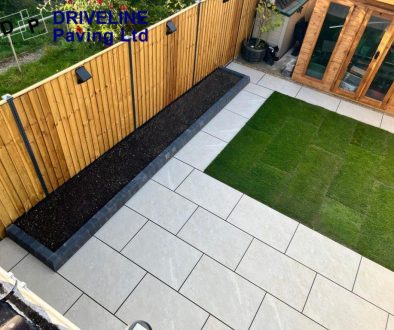August Driveway MOT: Spot and Fix Summer Damage Before Autumn
When you hear the term “MOT,” you probably think of your car’s annual inspection. But your driveway deserves the same kind of attention. After months of heat, sunlight, and summer activity, August is the ideal time to check its condition. This is when small issues can be spotted before autumn’s rain and colder weather make them worse.
Driveways face seasonal stresses just like any other part of your home. By taking a methodical approach now, you can save money on future repairs and keep your driveway looking and performing at its best for years to come.
Summer Stress Factors That Affect Driveways
The summer months can be tough on driveway surfaces and their underlying base. Several environmental factors combine to create wear and tear that isn’t always immediately visible.
- Heat expansion and contraction – Materials expand during hot days and contract at night, putting stress on joints and surfaces.
- UV fading – Constant sunlight can bleach colours, particularly in resin and block paving, making them look aged before their time.
- Drying of jointing materials – In block paving, the sand between joints can dry out and loosen, causing movement in the blocks.
- Softening of asphalt – High temperatures can cause tarmac to soften, making it more susceptible to ruts from vehicle tyres.
- Weeds and vegetation growth – Warm weather encourages weed growth along edges and in surface cracks.
Together, these factors mean that by August, your driveway has already been through a season-long endurance test.
Step-by-Step August Driveway MOT Checklist
Just like a vehicle MOT, your August driveway check should be systematic. Here’s a process you can follow to ensure nothing is overlooked:
- Visual inspection – Look for cracks, dips, or uneven areas across the whole surface.
- Check drainage performance – After a summer rain, see if water drains away properly or pools in certain spots.
- Test block stability – If you have block paving, gently press or rock a few blocks to see if they move.
- Look for weeds or moss – Check for signs of growth that may weaken the surface or cause trip hazards.
- Note fading or staining – Identify any surface discolouration or stubborn marks from oil, leaves, or other materials.
Completing this checklist gives you a clear picture of the driveway’s condition and helps prioritise repairs before the weather turns.

Common Types of Summer Damage and Their Solutions
If your inspection reveals problems, addressing them promptly is essential. The type of damage determines the best course of action.
- Cracks and small holes – These should be filled with a suitable patching material to stop water getting into the base and causing further deterioration.
- Faded or worn surfaces – Applying a seal coat or resurfacing restores colour, protects against UV damage, and extends the driveway’s life.
- Loose blocks or pavers – Re-levelling and re-sanding joints keeps the surface even and secure.
- Drainage issues – Clearing blockages, regrading the surface, or adding drainage channels ensures water flows away from your property.
- Weed growth – Remove existing weeds and apply a preventive treatment to slow regrowth.
Tackling these problems in late summer means you go into autumn with a driveway that is both structurally sound and visually appealing.
Why Addressing Summer Damage Now Saves Money Later
Delaying driveway repairs might seem harmless, but even minor flaws can worsen quickly once the weather changes. Autumn brings heavier rain, which can infiltrate cracks, soften the base, and lead to frost damage in winter.
By acting in August, you prevent water ingress, reduce the risk of costly base repairs, and avoid safety hazards caused by loose surfaces. A little maintenance now can add years to your driveway’s lifespan, protecting your investment and your home’s kerb appeal.
Professional Maintenance vs. DIY Repairs
Some driveway repairs can be handled by homeowners, but others benefit from professional expertise.
- DIY-friendly fixes – Small crack filling, weed removal, and minor cleaning tasks can often be done yourself with the right materials.
- When to call the experts – Significant cracks, sunken sections, drainage problems, or faded surfaces that need resealing are best left to professionals who have the right equipment and experience.
A professional inspection doesn’t just address existing issues—it also identifies underlying causes, ensuring you’re not simply patching over deeper problems.
Best Practices for Year-Round Driveway Care
Preventive care is the key to keeping your driveway in top condition. Adopting a regular maintenance routine ensures small issues are caught before they escalate.
- Seasonal cleaning – Sweep away debris regularly and wash the surface to prevent staining.
- Resealing schedules – For asphalt, apply seal coating every 2–3 years; for resin, reseal every 5–7 years depending on wear.
- Weed management – Use weed barriers, edge treatments, or regular herbicide application to keep vegetation in check.
- Drainage maintenance – Keep drains and channels clear of debris year-round to prevent water damage.
By sticking to these practices, you create a driveway that stays strong and attractive whatever the season.
Prepare Your Driveway for Autumn with Expert Help
August is the ideal time to give your driveway a thorough MOT. By spotting and fixing summer damage now, you avoid bigger, more expensive repairs later in the year. A professional service can make the process faster, more effective, and longer-lasting.
At Driveline Paving Ltd, we provide expert driveway inspections, repairs, and installations tailored to withstand the local climate in North London and Essex. Whether your driveway needs a quick touch-up or a more extensive restoration, our team uses high-quality materials and proven techniques to deliver results that last.
Contact Driveline Paving Ltd today to book your August driveway MOT and ensure your home is ready for the months ahead.





